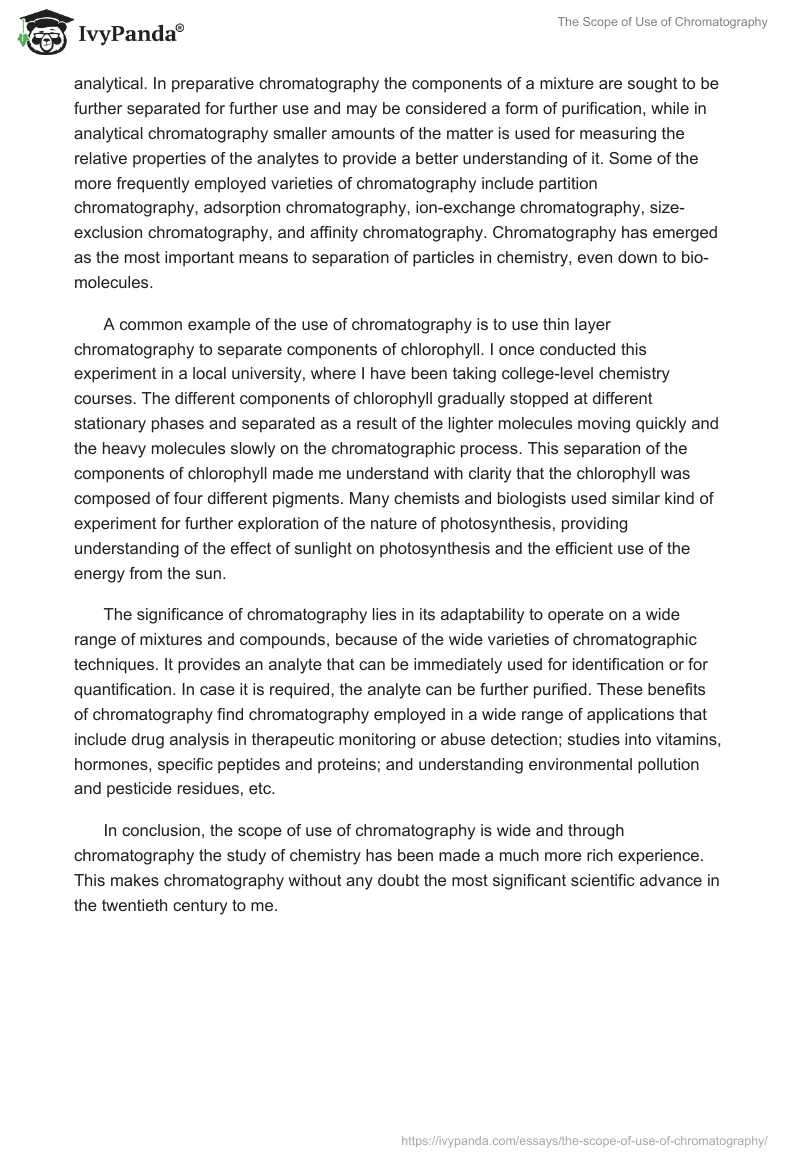There have been several remarkable advances in science that it is not easy to pick the most significant one. Given that chemistry underpins the conceptual framework and methodology of numerous other scientific disciplines, it is very likely that a breakthrough in chemistry would change and ameliorate the concepts in the entire scientific field. In my study of chemistry, in and out of class, I noticed that a remarkable advance took place in the beginning of the twentieth century namely chromatography.
Traditionally chemistry has been known as the study of the nature, properties and composition of matter, and how matter undergoes changes. Chromatography stands out as a remarkable advance in chemistry, as it advances the very core of chemistry, by increasing efficiency of studying the nature, properties, and composition of matter. The close association of chemistry with other branches of science like biology, geology and physics has meant that the greater understanding in the chemistry of matter, brought about through chromatography has contributed to advances on these other associated branches of science.
Chromatography technique came into being in 1900, through the efforts of the Russian botanist Mikhail Semyonovich Tsvet, while studying chlorophyll. More than five decades later an advance in chromatography technique in the form of partition chromatography gave its inventors, Archer John Porter Martin and Richard Lawrence Millinton Synge the Nobel Prize in 1952. Chromatography has continued to advance since then. The basic principles of chromatography have led to applications in many different ways, leading to the emergence of different varieties chromatography. Such advances have improved the technical performance of chromatography allowing chemical analysis at molecular and atomic levels.
Chromatography is a collective term that covers all the different laboratory techniques that are used for separation of mixtures. In chromatography a mixture is dissolved in a mobile phase and passed through a stationary phase, which enables the separation of the molecules chosen for analysis or the analyte from the other molecules present in the mixture. Put in simple terms chromatography makes use of the differing affinities among the analyte, the stationary phase, and the mobile phase to cause the separation of the analyte. Chromatography is used in two forms preparative or analytical. In preparative chromatography the components of a mixture are sought to be further separated for further use and may be considered a form of purification, while in analytical chromatography smaller amounts of the matter is used for measuring the relative properties of the analytes to provide a better understanding of it. Some of the more frequently employed varieties of chromatography include partition chromatography, adsorption chromatography, ion-exchange chromatography, size-exclusion chromatography, and affinity chromatography. Chromatography has emerged as the most important means to separation of particles in chemistry, even down to bio-molecules.
A common example of the use of chromatography is to use thin layer chromatography to separate components of chlorophyll. I once conducted this experiment in a local university, where I have been taking college-level chemistry courses. The different components of chlorophyll gradually stopped at different stationary phases and separated as a result of the lighter molecules moving quickly and the heavy molecules slowly on the chromatographic process. This separation of the components of chlorophyll made me understand with clarity that the chlorophyll was composed of four different pigments. Many chemists and biologists used similar kind of experiment for further exploration of the nature of photosynthesis, providing understanding of the effect of sunlight on photosynthesis and the efficient use of the energy from the sun.
The significance of chromatography lies in its adaptability to operate on a wide range of mixtures and compounds, because of the wide varieties of chromatographic techniques. It provides an analyte that can be immediately used for identification or for quantification. In case it is required, the analyte can be further purified. These benefits of chromatography find chromatography employed in a wide range of applications that include drug analysis in therapeutic monitoring or abuse detection; studies into vitamins, hormones, specific peptides and proteins; and understanding environmental pollution and pesticide residues, etc.
In conclusion, the scope of use of chromatography is wide and through chromatography the study of chemistry has been made a much more rich experience. This makes chromatography without any doubt the most significant scientific advance in the twentieth century to me.


